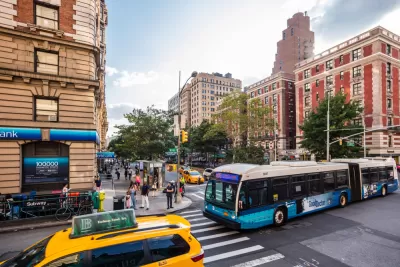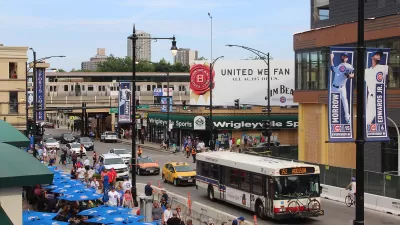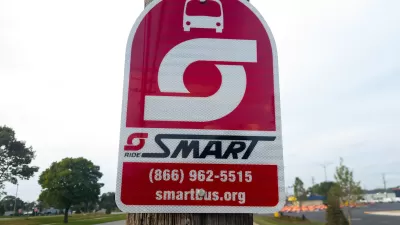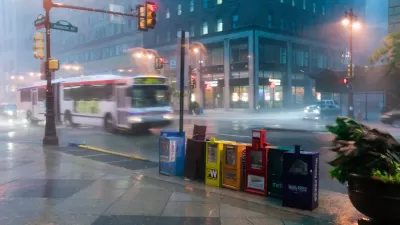Pre-signals offer the benefit of a dedicated lane on smaller streets that can't accommodate a dedicated bus lane.

Faster buses attract more riders and add capacity by speeding up travel, but sometimes street geometry doesn't accommodate dedicated bus lanes. "The democratizing force is a dedicated lane, which can allow buses to carry upwards of four times as many travelers per hour than a general traffic lane," reports Laura Bliss in CityLab.
When a street cannot accommodate a dedicated bus lane, as when there is traffic in both directions, no parking, and the street needs to remain two-way, one option to speed up buses is pre-signals. These traffic signals, currently in use in the United Kingdom and Switzerland, are placed before intersections and can stop traffic in both directions to let buses pass. These signals stop the cars, then the bus pulls into the lane formerly used for oncoming traffic to pass, as pictured in this animation.
"According to the simulations that the authors ran, the time-savings appears to be significant. Pre-signals can save bus travelers 5 to 7 seconds of delay per intersection at uncongested intersections, and up to 30 seconds of delay at congested intersections," Bliss reports.
FULL STORY: When is a Dedicated Bus Lane Not a Dedicated Bus Lane?

Planetizen Federal Action Tracker
A weekly monitor of how Trump’s orders and actions are impacting planners and planning in America.

The Simple Legislative Tool Transforming Vacant Downtowns
In California, Michigan and Georgia, an easy win is bringing dollars — and delight — back to city centers.

San Francisco's School District Spent $105M To Build Affordable Housing for Teachers — And That's Just the Beginning
SFUSD joins a growing list of school districts using their land holdings to address housing affordability challenges faced by their own employees.

In More Metros Than You’d Think, Suburbs are Now More Expensive Than the City
If you're moving to the burbs to save on square footage, data shows you should think again.

The States Losing Rural Delivery Rooms at an Alarming Pace
In some states, as few as 9% of rural hospitals still deliver babies. As a result, rising pre-term births, no adequate pre-term care and "harrowing" close calls are a growing reality.

The Small South Asian Republic Going all in on EVs
Thanks to one simple policy change less than five years ago, 65% of new cars in this Himalayan country are now electric.
Urban Design for Planners 1: Software Tools
This six-course series explores essential urban design concepts using open source software and equips planners with the tools they need to participate fully in the urban design process.
Planning for Universal Design
Learn the tools for implementing Universal Design in planning regulations.
Smith Gee Studio
City of Charlotte
City of Camden Redevelopment Agency
City of Astoria
Transportation Research & Education Center (TREC) at Portland State University
US High Speed Rail Association
City of Camden Redevelopment Agency
Municipality of Princeton (NJ)





























